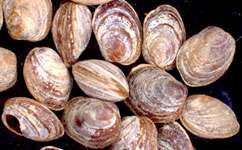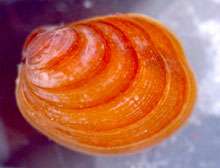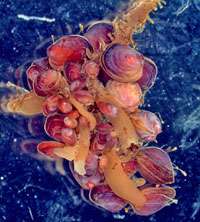Warming waters take their toll on Antarctic shellfish

Shells that spent decades sitting ignored in a Welsh museum have shown scientists that climate change is seriously harming ecosystems around Antarctica.
The researchers found that members of one shellfish species are being assailed by algae, forcing them to put more energy into repairing their shells and reducing the resources available for reproduction.
Their paper also highlights the need for long-term studies so we have a realistic baseline against which to measure changes. Otherwise, researchers risk falling into the trap of 'shifting baselines', in which they all measure change against whatever the situation happened to be when they started their career.
Adam Reed of the University of Southampton and National Oceanography Centre has been working on the bivalve species Lissarca miliaris for his PhD, looking at their ecology and response to a warming climate - Antarctic waters have heated up by an average of 0.56°C per decade since 1950, and many plants and animals are showing the strain.
He already had access to shells collected in 2002 by researchers at the British Antarctic Survey's Signy Research Station, and asked them to get more of the tiny bivalves. When they obliged, there seemed to be significant differences between the two.
But without much older samples, it was hard to know if this part of a long-term trend or just a temporary fluctuation. One paper published in 1979 included some data on L.miliaris shells that had been collected in 1972, but the samples themselves had long been lost and there was nothing between then and 2002.

So he contacted museums all over the UK in search of earlier specimens. Only one could help - the National Museum of Wales, which turned out to have around 200 shells that had been collected around Signy in 1976 and somehow ended up in storage in Cardiff.
By analysing each shell's chemical composition, researchers can deduce many properties of the water it formed in. Reed says that L.miliaris is a particularly good climate record, since it is relatively short-lived, rarely making it beyond seven years.
Researchers have looked at bigger, longer-lived species before, but because their shells are formed over a much longer period - sometimes as much as 70 years - they don't provide a detailed picture of short-term changes.
One striking feature of modern shells compared to old ones is that they are thicker but less sturdy. Reed says that that the shellfish are now constantly covered with an algal film, and that this seems to be dissolving their shells.
The animals respond with hasty regrowth, leaving their shells thicker than they started out. But this so-called 'secondary calcification' is nowhere near as good as the original shell - under an electron microscope, it's clearly much more brittle and porous. So the bivalves are spending a lot of energy on repairs, but ending up worse off than they started.
'We think the algae were probably always there, but may have been killed off during cold winters,' Reed says. 'The warmer conditions in the last decade may mean this doesn't happen any more.' It's not yet certain how this is affecting the shellfish as a whole, but the effects are unlikely to be positive. Studies of populations over time are needed to find out for sure, but already the average size of L.miliaris larvae is dropping.
The idea of shifting baselines isn't new; it's a recognised problem in fisheries science. In that field, scientists realised in the 1990s that it was impossible to measure long-term changes objectively without a commonly-agreed baseline to start from. But this is the first hard evidence linking the concept to the effects of climate change on Antarctic ecosystems.
'Where do we measure change from?' Reed asks. ' Here we have gone back 40 years, but we don't really know if that's enough - we'd like to go back even further if we could find older shells. But this is the problem with Antarctica - we just haven't been sampling it for very long.'

He suggests that researchers need to be open-minded about finding new ways of learning about the history of the climate. 'People need to look more creatively at how we can use what data we do have,' he explains. 'This will probably involve more collaboration, working with museums and other collections.'
He's now looking at extending the research to other places in Antarctica, like South Georgia. In the meantime, if any readers happen to have a cache of old Lissarca miliaris shells sitting around, he'd be delighted to hear from you.
The paper appears in PLoS ONE.
More information: Reed AJ, Thatje S, Linse K (2012) Shifting Baselines in Antarctic Ecosystems; Ecophysiological Response to Warming in Lissarca miliaris at Signy Island, Antarctica. PLoS ONE 7(12): e53477. doi:10.1371/journal.pone.0053477
Journal information: PLoS ONE
Provided by PlanetEarth Online
This story is republished courtesy of Planet Earth online, a free, companion website to the award-winning magazine Planet Earth published and funded by the Natural Environment Research Council (NERC).


















